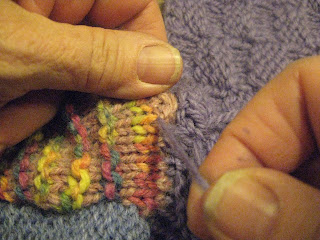Roz Chast is one of my favorite New Yorker cartoonists, but this time, she delivered an insult.
"Crap somebody knitted"? Crap?
Roz must not be a knitter, or she would have more appreciation for the artistry, effort, and dogged determination required to produce a significant knitted creation.
I'm just now finishing a knitting project so time-consuming it makes the labor of Sisyphus look like taking out the trash. Roz, this is no crap, this is a creative effort requiring extensive commitment over a period of many months.
It was the winter of 2010, and I had pneumonia. I couldn't do much, but I could knit.
Lucia had been bugging me about knitting her an afghan.
"Julia and Leah got theirs when they started college." (Lucia had just started at the University of Vermont). "How come I don't have one?"
"Because I like Julia and Leah better!"
Still, despite the fact that Lucia and I sat down on several occasions to look at patterns and try to make some decisions about what I could make for her, there were too many choices, and our discussions always ended inconclusively.
So when the pneumonia sidelined me in the winter of 2010, I decided to use this period of inactivity to go ahead and start an afghan and surprise Lucia later with the finished product. I knew that this afghan had to use a lot of her favorite color, purple. I chose size six needles for all the blocks.
This is the book I decided to use. My goal: 48 afghan squares.
Squares were such an easy choice at the time. One square knits up so quickly. Sitting in my glider rocker, I could knit up 48 easily.
So I did.
Here's a look at a few of them:
This one's my favorite: colorful, sturdy, and easy to execute. My book calls it Up and Over.
This one took a whole lot of paying attention. The book calls it Lace Chevrons.
This one also took a lot of attention. The book calls this pattern Shutter. For it, I worked a color pattern by the intarsia method. For the first time. Whoo hoo!
This is another intarsia method block requiring a lot of attention. The book called it Big Heart.
This one's my favorite: Embossed Twining Vine Leaf, a block adapted from a different book, Vogue Knitting.
Crap?
I think not.
The creation of these squares required a lot of skill.
Still, I have to say, sewing them together required a lot of determination, and that's where a good idea under pneumonia circumstances turned out to be a labor-intensive pain in the ass later.
That's why I'm calling this blog entry "Seemed Like a Good Idea at the Time Dept."
Roz, you have to respect the effort required to sew these 48 squares together, first, into pairs, then into eight rows of six squares each.
Did I mention the Sisyphus part yet?
I'm not a knitter with a whole lot of techniques in her tool pouch. I know only one way to sew two knitted items together: the mattress stitch.
Many thanks to Judy Perodeau of the late, great Needleworks, Newington, CT, who taught me this sturdy but time-consuming stitch.
The mattress stitch uses the concept of the shared hole.
Are you with me?
A shared hole is one through which the yarn and needle have already passed and will now pass again.
This is a shared hole:
To execute a mattress stitch, you insert a needle into a shared hole, like so:
Once the needle goes into the shared hole, then it has to go up two stitches of the ladder. This is what "two stitches of the ladder" means.
Once the needle and yarn traverse these two stitches of the ladder, they have to go over to the other side, into the most recent shared hole on that side, and the journey begins again.
Once the squares and rows are laboriously sewn together, I have to deal with the fact that the reverse side of this afghan is a welter of hanging threads.
Did I mention Sisyphus?
This is how I feel as I drag this project to completion:
But who's complaining?













No comments:
Post a Comment